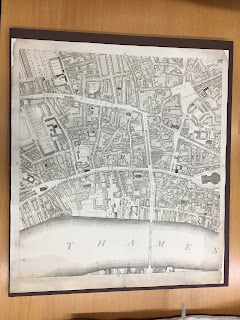On another lovely London day we made our way to King's College where we met Head of Special Collections, Katie Sambrook and Special Collections Manager, Adam Ray. Before showing us a selection of fascinating pieces from their collection they discussed with us the scope and purpose of the collection.
This staff of 8 oversees the Liddell Hart Centre for Military Archives, King's College London Archives, and the Foyle Special Collections Library. They encourage all students and staff of King's College to use Archives & Special Collections and seek assistance from the knowledgable staff but the also welcome the public.
 |
| An item with Benjamin Franklin's signature in the upper right corner |
In their work to bring people to the Archives & Special Collections they create exhibitions and supply images of rare books and archives for conferences, festivals, fundraising, and Alumni Weekend.
They also are a lead partner in AIM25 which is an online portal which provides access to archives catalogues of more than 150 institutions in the London area.
On their website they have links to the documents describing their collection development and information policies. It also lists their Collection Management Policies in which they seek to ensure:
- "That our collection are developed so as to build on existing strengths in accordance with a logical and sustainable collection development policy."
- "That our collections are managed in accordance with national and international standards of responsible stewardship so as to ensure their long-term preservation."
- "That our collection are promoted not only within King's but to the wider scholarly community and to the general public (by, for example, the loan of items for public exhibition)."


Comments
Post a Comment